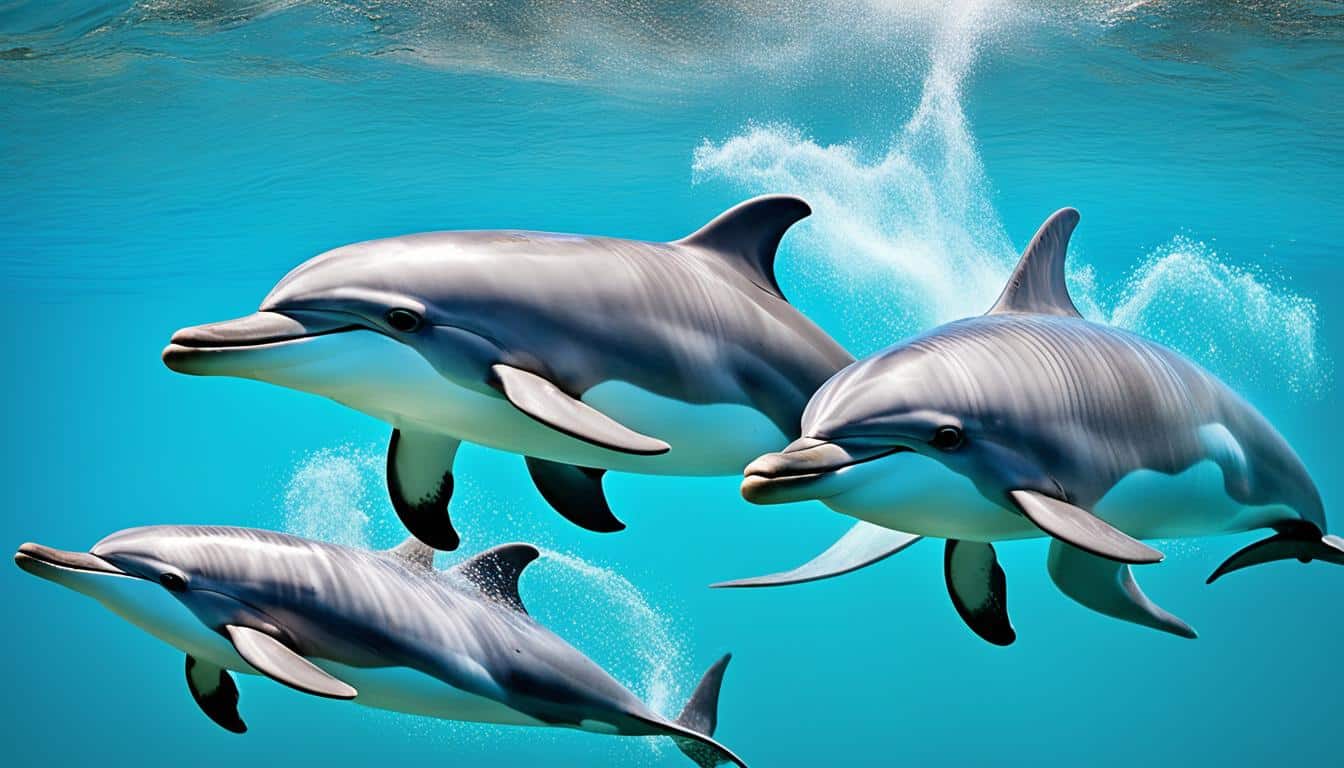Dolphin communication is fascinating and shows how smart these sea creatures are. You might ask, how do dolphins talk to each other? Studies reveal that dolphins use many sounds and signals to share info and build relationships. Since sound travels faster in water, hearing is key for them. Learning about dolphin communication helps us see how smart and social they are.
Understanding Dolphin Communication
Dolphin communication is a fascinating study that includes sounds, body language, and social signals. These methods help dolphins build complex social networks. They show amazing communication skills, from caring for their young to socializing in groups.
Scientists are still learning about how dolphins talk to each other. Dolphins use clicks, whistles, and other sounds to share information. This shows they are very intelligent and social creatures.
How dolphins communicate is still a mystery that scientists are trying to solve. They have learned a lot, but there’s still much to discover. By learning more, we can appreciate the deep relationships dolphins have under the sea.
Types of Vocalizations in Dolphins
Dolphins make many sounds to talk to each other in their groups. They use special sounds like signature whistles and pulsed sounds. These help us understand how they talk and share important info.
Signature Whistles
Signature whistles are a big part of dolphin communication. Each dolphin has its own whistle that’s like a name. This helps them know who’s who in their group.
These whistles can show how a dolphin feels, like happy or upset. Dolphins can tell each other apart by these sounds. This shows how smart they are at social stuff.
Pulsed Sounds
Pulsed sounds include things like yelps and clicks. They are important for talking and hunting together. Dolphins use these sounds to get everyone’s attention and work together.
The way they make these sounds can tell others if something is urgent or exciting. This helps them work better together when they’re hunting for food.
How do dolphins communicate?
Dolphins have amazing ways to talk to each other. They use complex sounds to share messages, feelings, and plans. These sounds include beautiful whistles and quick clicks, showing how smart they are.
When you watch dolphins, you’ll see them copy each other. This copying helps them connect and understand their world better. They can change the shape of their blowhole to make different sounds. This helps them talk clearly over long distances.
Dolphins don’t just use sounds to talk. They also use body language like how they stand and swim. This mix of sounds and body language shows how complex their conversations are. It shows they have a deep social life under the sea.
The Role of Echolocation in Dolphin Interaction
Dolphins have a unique way called dolphin echolocation that helps them survive and interact in their world. This skill lets them navigate and communicate in different places. It’s key for their survival and social life.
How Echolocation Works
Dolphins send out clicks as part of echolocation. These sounds bounce back when they hit something. Dolphins use these echoes to figure out the size, shape, and distance of objects. This is super useful in murky waters where they can’t see well.
Benefits of Echolocation for Dolphins
Echolocation does more than just help dolphins find their way. It’s also key for how they talk to each other. Dolphins use it to stay in touch with their group, which is important for hunting together. It helps them work as a team and catch more fish.
| Benefit | Description |
|---|---|
| Navigation | Helps dolphins move effectively in various aquatic environments, especially where it’s hard to see. |
| Prey Detection | Assists dolphins in finding and identifying food by checking out object details. |
| Pod Positioning | Keeps dolphins aware of where their friends are, making their communication better. |
| Cooperative Hunting | Makes hunting together more successful by helping dolphins work as a team. |
Dolphin Social Interactions and Their Communication
Dolphins are truly smart sea creatures, showing off their complex social lives. They work together to hunt, using their communication skills. They use sounds and body language to catch fish in groups, making it easier to eat.
Dolphins live in groups with clear social ranks, built on strong friendships. They talk to each other in many ways, like with special sounds and body moves. Their social life is full of fun activities that help keep their group strong.
These sea animals also feel emotions, which makes their social life even more interesting. Studies show they care for each other, support each other in hard times, and celebrate together. This shows how important talking is for dolphins to keep their friendships strong.
Visual and Non-Vocal Communication in Dolphins
Dolphins have a special way of communicating that goes beyond just making sounds. They use visual signals and touch to talk to each other. This helps them connect in their social groups.
Body Language and Gestures
Dolphins use body language to send messages. Things like slapping their tails or jumping out of the water show different feelings. These actions warn others of danger and help dolphins feel close to each other.
By watching these behaviors, we can learn about the complex social lives of dolphins. It shows us how they form close bonds within their groups.
Communication through Touch
Communication through touch is key for dolphins. They nuzzle or swim close to each other to strengthen their bonds. This touch is important for dolphins, especially between mothers and their babies. It shows that touching is as important as making sounds in building relationships among dolphins.

The Fascinating Complexity of Dolphin Language
Dolphins are seen as smart sea mammals that catch the eye of researchers with their complex ways of talking. They are being studied to see if they have a language like ours. Learning about dolphin communication shows how they can pick up on artificial languages, making us wonder about their thinking skills.
Even with the research, we can’t say for sure if dolphins have a language as complex as ours. Their sounds and social actions hint at a deep way of expressing thoughts and feelings. Looking into this, we see the hard work to understand dolphin language and their amazing brain power.
Studying dolphin communication helps us get to know these amazing beings better. It shows their social skills. As research goes on, we learn more about how they see and talk to each other and their world, proving they are among the most interesting sea creatures.
FAQ
How do dolphins communicate with each other?
Dolphins talk to each other using sounds, body language, and social signals. They use sound to share important info and keep their pod together. This method works well in water.
What types of vocalizations do dolphins use?
Dolphins make different sounds like signature whistles and pulsed sounds. These include clicks and yelps for talking and hunting. Each dolphin has its own whistle, like a name, to show who they are and how they feel.
What is echolocation and how do dolphins use it?
Echolocation is a way dolphins find their way and find food. They send out clicks and listen for the echoes to know where things are. This helps them hunt and talk to each other in the dark water.
Do dolphins have a form of language?
Dolphins are smart and can learn human language, but they don’t have a language like ours. Scientists are still studying how dolphins communicate. They want to know if dolphins can share complex ideas and feelings.
How do social interactions impact dolphin communication?
Dolphins live in groups and work together to hunt and play. This shows how smart and connected they are. They use sounds and body language to talk and strengthen their bonds, especially with their mothers.
What role do visual and non-vocal signals play in dolphin communication?
Dolphins also use body language and touch to communicate. They use postures, gestures, and touch to show feelings, ask for help, and build relationships. This is very important for mothers and their babies.







